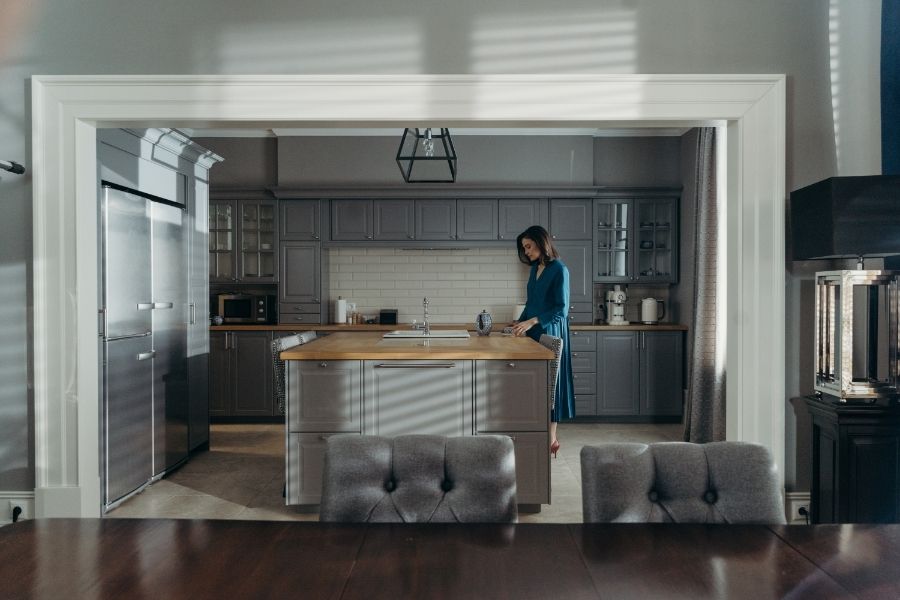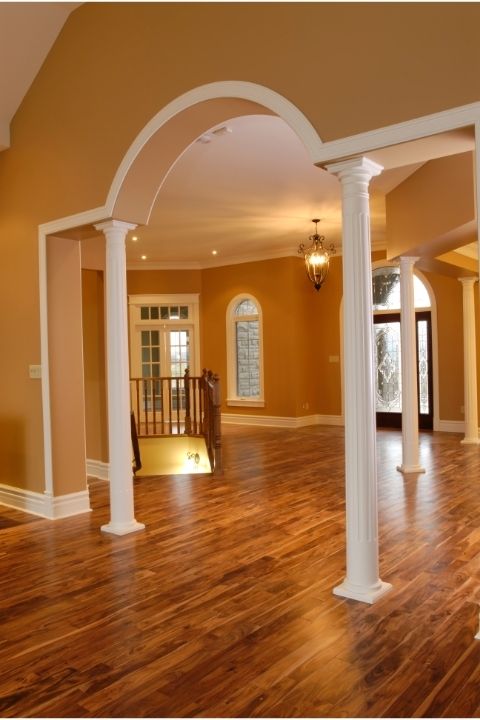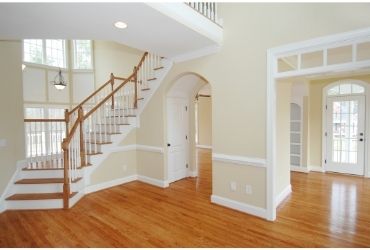 If you’re wondering, what crown molding is best for archways? you’re probably looking to jazz up a room (one with an archway) and are looking for a solution. After all, installing crown molding is a great way to add value to a house by improving its appearance and feel. It makes both formal and casual interiors look and feel more elegant and cozy.
If you’re wondering, what crown molding is best for archways? you’re probably looking to jazz up a room (one with an archway) and are looking for a solution. After all, installing crown molding is a great way to add value to a house by improving its appearance and feel. It makes both formal and casual interiors look and feel more elegant and cozy.
Historically, archways set the tone for a smooth and consistent interior house finish. Today, archway crown molding is a defining feature in any historic house. Actually, there are numerous designs and profiles that can enliven your archways and entire house as long as you choose the right scale and proportions.
Related Posts: What is the Best Cordless Finish Nailer?
What Crown Molding is Best for Archways?

The best crown molding for archways is flexible polymer crown molding. It’s not only cheaper than custom wood crown molding but you can also stain or paint it to match your home’s interior décor. Even better, flexible polymer crown molding doesn’t crack, warp, or rot, and you can work on it easily using standard woodworking tools.
Generally, the best crown molding for archways is one that ties the entire house’s trim in a smooth and consistent finish. It highlights the archways in rich detail and rekindles the feeling of permanence presented by traditional building styles.
Related Posts: Can Crown Molding be Installed on a Vaulted Ceiling?
Flexible polymer crown molding is an unbeatable choice for archways finishing. It’s extremely easy and convenient to cut and install around curves where installing inflexible crown molding is difficult, costly, and time-consuming. Some flexible polymer crown moldings even replicate the natural grain and beauty of natural wood crown molding.

Related Posts: Where Can You Buy Crown Molding?
Using crown molding kits is another great way to install crown molding on archways. These are particularly effective when installing crown molding on half-round archways. The keystone piece cups the archway’s head while the fluted pilasters install on the sides (legs) of the passageway. Better still, a supplied template enables you to create a curved archway in an existing square opening.
Best of all, you can build any style of archway crown molding from standard stock crown molding. You can combine simple and inexpensive pieces of crown molding into an elaborate profile for your archway crown molding project. Just ensure you get the scale and proportion right for a smooth and consistent finish.
Is Crown Molding Still in Style?

Absolutely! Installing crown molding is still a stylish way to finish your historic house. It’s an efficient way to conceal structural flaws and minor blemishes, and make a house interior look and feel more elegant. Nevertheless, the design, size, and color of the crown molding should mirror the style, size, locale, and formality of your house.
Related Posts: When to Paint Crown Molding
Crown molding is appropriate in some styles of houses while it looks absurd in others. It’s considered a worthy upgrade in traditional, colonial, transition, and other historic houses such as Victorian, Georgian, Craftsman, and Colonial revivals.
On the other hand, crown molding would look out of place on contemporary-style houses. Modern houses are best suited to other trim finishing choices such as wallpapers and picture moldings. Besides, crown molding doesn’t align well with most contemporary cove and cathedral ceiling designs.
Related Posts: What is the Purpose of Crown Molding?
Initially, crown molding was used to cover architectural imperfections. That’s no longer necessary in most modern houses with solid drywall. Historic homes also have plenty of woodwork that aligns perfectly with crown molding. Conversely, most contemporary houses are built plainly, and crown molding mostly looks out of place here.
Although crown molding is still a stylish house upgrade, installing it relies on the style of your house, your neighborhood, designer’s recommendations, budget, and personal taste.
How Do You Match Crown Molding to Baseboards?
Matching crown molding to baseboards is a mostly a matter of personal preference. You can bend or break any established rules especially if you’re skilled in house remodeling. The crown molding and baseboards shouldn’t look exactly the same but must mirror a similar design for a cohesive finish.
Related Posts: How Much is Crown Molding?
Crown molding frames your house by covering the top of the walls and base of the ceiling while baseboards tie together the interior design at the base of the walls. You can mix and match these two trim as you please as long as they complement each other and the entire room.
Most crown molding experts recommend matching two trims and then keeping the other one in a complementary size, style, or color for a consistent appearance. To coordinate your crown molding and baseboards, consider these three elements:
- Color
- Style
- Size
Color
Matching the color of your crown molding and baseboards is the easiest way to coordinate these two elements. If these two trims have different designs and sizes, you can tie them together by painting them the same size. Despite the differences in style and size, the color brings a cohesive look to the entire interior décor.
Related Posts: What is the Best Crown Molding Jig?
Style
Using crown molding and baseboards of a common style is another great way to match these two trims. The sizes and color can be different, but the style unifies the elements in one smooth and cohesive finish. Better still, you can match the style and color of the crown molding and baseboards for a more consistent look.
Size
You can also achieve symmetry in your interior décor by using crown molding and baseboards of the same size. If the elements are of a similar width, they can still match even when their styles and colors differ. For instance, the baseboards and furniture trim can be white while the crown molding is white and still have a unifying appearance as long as their sizes are similar.
Related Posts: Cutting Crown Molding Flat (and how to install it)
Be creative and mix-and-match the styles, sizes, and colors of the crown molding and baseboards. The only catch is that you should ensure at least one element is common in both trims. This way, you’ll still achieve a beautiful and cohesive house interior regardless of the other subtle differences.
What is the Easiest Crown Molding to Install?
Polymer (polyurethane and polystyrene) crown moldings are the easiest to install. They’re lightweight, so you can whisk them up and install on your own. What’s more, these crown moldings are easy to prime, mold, measure, and cut with standard woodworking equipment.
Related Posts: How to Measure Crown Molding
What’s more, most polymer crown moldings are pliable and install easily around corners. Better still, some install using glue. This saves you the hassle, time, and cost of nailing the crown molding in place.
Crown molding with easy install kits is another effortless way to install crown molding. These kits consist of stock pre-made crown molding pieces and mitered corners that fit perfectly into each other. All you need to do is understand how to take the measurements of your crown molding and house, determine your preferred crown molding style, pick your crown molding pieces, and then choose matching corners.
Is Crown Molding Hard to Install?
Crown molding can be hard to install depending on the type of material and style you choose. Crown molding materials that require extensive workmanship such as wood take expertise, time, and effort to set up. This also impacts how much you spend for the entire project.
Your level of workmanship also determines whether installing crown molding is easy or hard. For instance, coping crown molding joints is harder and takes more time than using mitered joints. To cope a joint successfully, you need mastery of the craftsmanship whereas using mitered joints is a breeze.
Related Posts: Best Rope Lights For Crown Molding
The mode of crown molding installation you choose also impacts the ease or complexity of the project. Measuring, marking, folding, and nailing the individual pieces takes a lot of time and effort. If you prefer a simpler method, using simple crown molding install kits saves time and effort. You don’t even need to be an expert woodworker to hack the project.
The way you hang your crown molding on the wall and ceiling also determines whether installation is easy or hard. Nailing the crown molding pieces in place using nails and studs is an intricate process that takes time, effort, and skill. On the other hand, it’s easy to stick the pieces in place using glue. The disadvantage of the latter is that only a few types of polymer crown moldings contain glue.
Installing crown molding can also be hard when you consider the various pre-installation and post-installation processes. Priming, measuring, cutting, caulking, and painting the pieces take time, skill, and effort.
Final Thoughts
Installing the best crown molding on archways can make a home look and feel more magnificent and add to the value of the house. These curved entryways highlight the architectural finesse in vivid detail and finishing them with crown molding revives the original features of a house. You can enliven the space further by installing suitable rope lights for your crown molding.
